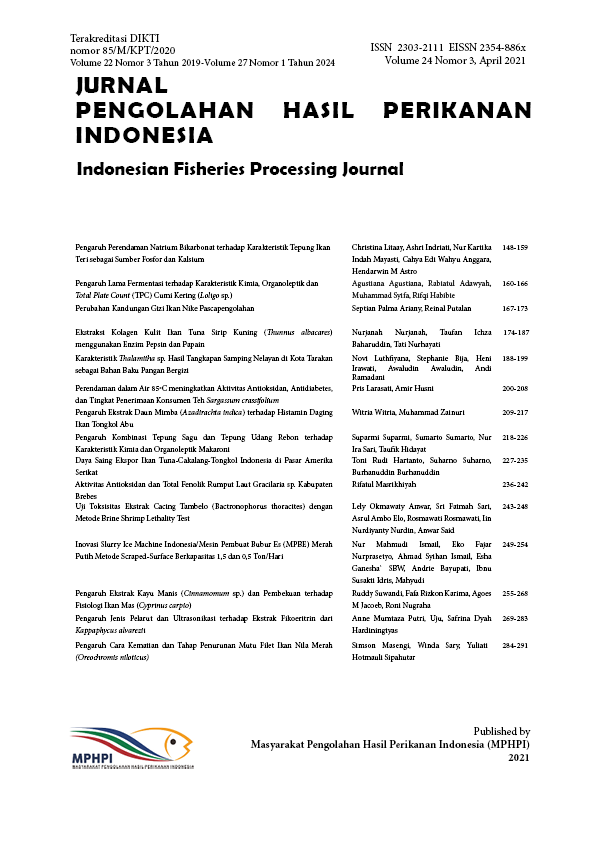Uji Toksisitas Ekstrak Cacing Tambelo (Bactronophorus thoracites) dengan Metode Brine Shrimp Lethality Test Toxicity Test of Wood-boring Shipworm (Bactronophorus thoracites) using Brine Shrimp Lethality Test
Abstract
Shipworm, local name tambelo, is an organism that live on dead Rhizophora sp timbres. The objective of this research was to determine the toxicity of shipworm extract using brine shrimp lethality test. Shipworm were collected from mangrove forests of Moolo Village, Batukara Subdistrict, Muna District, in Southeast Sulawesi. Extract of shipworm was prepared using methanol solvent. Toxicity test by brine shrimp lethality test was done through two stages of testing, preliminary and definitive test. Preliminary test was aimed to determine the range of lethal concentration (LC50), this range was used in the next definitive test. The preliminary test used a concentration of 10, 100, 1,000; and 0 μg.ml-1 as control. The definitive test used 4 concentrations in triplicates, 17,78, 31,61, 56,21, 99,94, and 0 μg.ml-1 as control. Data obtained from definitive test were subjected to probic analysis. The analysis showed that LC50-24hours of tambelo extract was equal to 42,431 μg.ml-1. LC50 value indicated that the toxicity of shipworm was very toxic to brine shrimp.
References
Anderson JE, Goetz CM, Mc Laughlin JL. 1991. A Blind Comparison of Simple Bench-top Bioassay and Human Tumor Cell Cytotoxicities as Antitumor Prescrenss, Natural Product Chemistry. Amsterdam (NL): Elsevier.
Anwar LO. 2015. Komposisi Kimia Tambelo (Bactronophorus sp.) dan Karakteristik Produk Hasil Fermentasinya. [Tesis]. Bogor. Institut Pertanian Bogor.
Anwar LO, Harjito L, Desniar. 2016. Fermentasi tambelo dan karakteristik produknya. Jurnal Pengolahan Hasil Perikanan Indonesia.17(3): 254-262
Arcanjo DDR, Albuquerque ACM, Melo-Neto B, Santana LCLR, Medeiros MGF, Citó AMGL. 2012. Bioactivity evaluation against Artemia salina Leach of medicinal plants used in Brazilian Northeastern folk medicine. Brazilian Journal of Biology. 72 (3): 505-509
Carballo JL, Hernández-Inda ZL, Pérez P, García-Grávalos MD. 2002. A comparison between two brine shrimp assays to detect in vitro cytotoxicity in marine natural products. BMC Biotechnology. 2: 17.
Clarkson C, Muharaj VJ, Crouch NR, Grace OM, Pillay P, Matsabisa MG, Bhagwandin N, Smith PJ, Folb PI. 2004. In vitro antiplasmodial activity of medicinal plants native to or naturalized in South Africa. Journal of Ethnopharmacology. 92: 177-191.
Hardiansyah, Sumule A, Letsoin J. 2007. Jenis dan jumlah konsumsi tambelo, siput dan kerang oleh penduduk di Kawasan Muara Mimika, Papua. Jurnal Gizi dan Pangan. 1(1): 1-12.
Haris A, Werorilangi S. 2009. Uji Sitotoksitas Ekstrak (Crude Extract) Karang Lunak (Octocorallia alycyonacea) dari Kepulauan Spermonde Kota Makassar. Fakultas Ilmu Kelautan dan Perikanan Universitas Hasanuddin.
Khopkar M. 2003. Konsep Dasar Ilmu Analitik. Jakarta: UI-Press.
Leiwakabessy L. 2011. Komposisi Kimia dan Identifikasi Senyawa Antioksidan dari Ekstrak Tambelo (Bactronophorus thoracites). [Tesis]. Bogor. Institut Pertanian Bogor.
Martiningsih NW. 2013. Skrining Awal Ekstrak Etil Asetat Spons Leucetta sp. Sebagai Antikanker dengan Metode Brine Shrimp Lethality Test (BSLT). Semnas FMIPA Undiksha 2013.
Mc. Laughlin J L, Chang C J, Smith DL. 1991. Bench-top, bioassay for the discovery of bioactive naturals products, an update. Natural Product Chemistry. Amsterdam (NL): Elsevier.
Mc. Laughlin JL, Rogers LL. 1988. The use of biological assay to evaluate botanicals. Drug Information Journal. 32: 513-514.
Meyer BN, Ferrigni NR, Putnam JE, Jacobsen LB, Nichols DE, Mc. Laughlin JL. 1982. Brine shrimp: a convenient general bioassay for active plant constituent. Planta Medica. 45: 31-34.
Michael AS, Thompson CG, Abramovitz M. 1956. Artemia salina as a test-organism for bioassay. Science. 123: 464.
Mursyidi A. 1984. Statistik Farmasi dan Biologi. Cetakan I. Ghalia Indonesia: Jakarta.
Priyanto. 2009. Toksikologi: Terapi Antidotum dan Penilaian Resiko. Lembaga Studi dan Konsultasi Farmakologi. Jakarta.
Riviani, Purwaningsih S, Tarman K. 2016. Profil asam amino, asam lemak, kandungan mineral tambelo (Bactronophorus sp.) dari Kendari Sulawesi Tenggara. Jurnal Pengolahan Hasil Perikanan Indonesia. 19(1): 51-57
Sleet R.B., dan Brendel K., 1983. Improved Methods for Harvesting and Counting Synchronous Population of Artemia Nauplii for Use in Development Toxicology. Ecotoxicology and Environmental Safety. 7: 435-446.
Trindade Silva E, Machado-Ferreira E, Senra MVX, Vizzon VF,Yparraguirre LA, Leoncini OA. 2009. Physiological traits of the symbiotic bacterium Teredinibacter turnerae isolated from the mangrove shipworm neoteredo reynei. Genetics and Molecular Biology. 1:1.
Tunner R.D. 1971. Identification of Marine Wood-Boring Mollusks. In: Jones E.B.G. and Eltringham, S.K., (Ed.) Paris:Marine Borers, Fungi, and Fouling Organisms of Wood. OECD. 17-64.
Uddin M, Pervin R, Kabir Y, Absar N. 2013. Preliminary Screening of Secondary Metabolites and Brine Shrimp Lethality Bioassay of Warm-Water Extract of Puffer Fish Organs Tissue, Tetraodon cutcutia, Available in Bangladesh. Journal of Biomedical and Pharmaceutical Research 2(5):14-18.
Vanhaecke P, Persoone G, Claus C, Sorgeloos P. 1981. Proposal for A Short-Term Toxicity Test with Artemia Nauplii. Ecotoxicology and Environmental Safety. 5: 382-387.
Authors

This work is licensed under a Creative Commons Attribution 4.0 International License.
Authors who publish with this journal agree to the following terms:
- Authors retain copyright and grant the journal right of first publication with the work simultaneously licensed under a Creative Commons Attribution License that allows others to share the work with an acknowledgement of the work's authorship and initial publication in this journal.
- Authors are able to enter into separate, additional contractual arrangements for the non-exclusive distribution of the journal's published version of the work (e.g., post it to an institutional repository or publish it in a book), with an acknowledgement of its initial publication in this journal.





